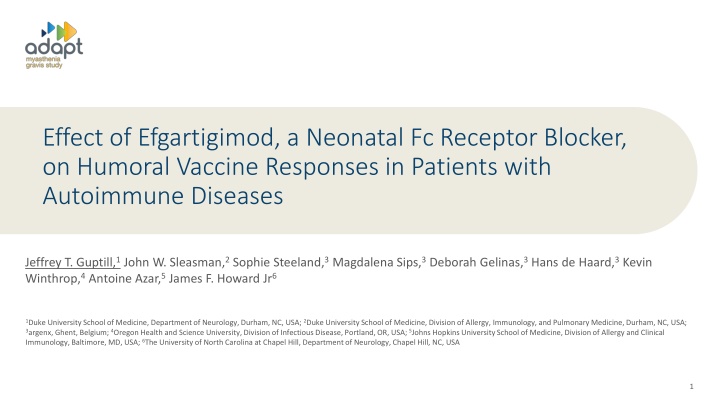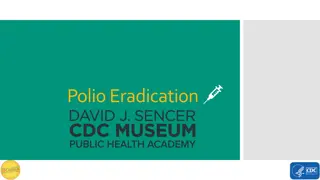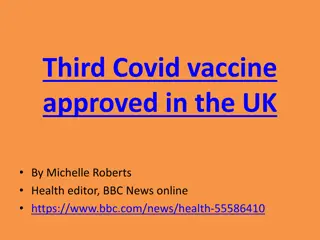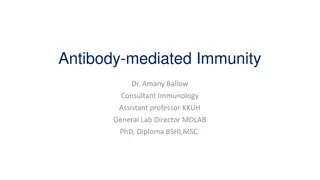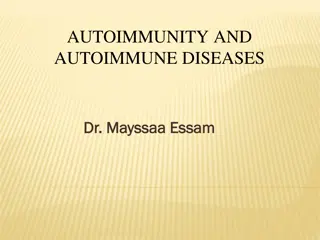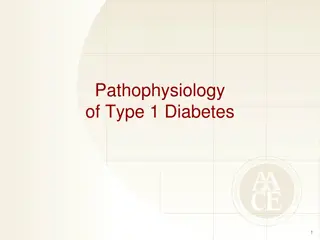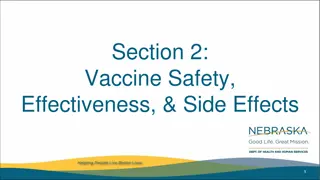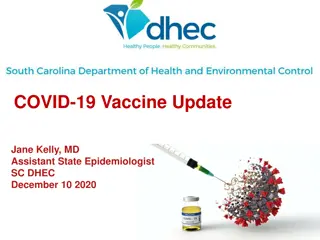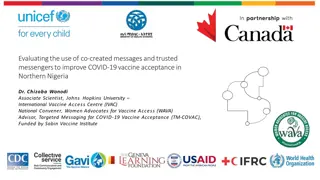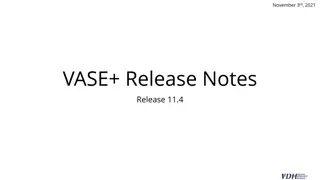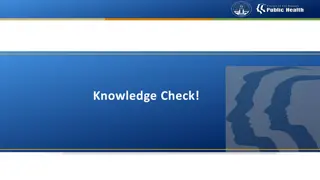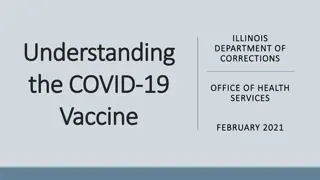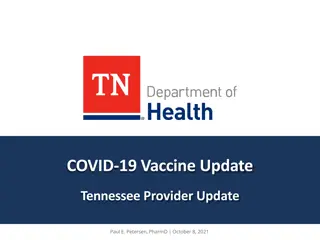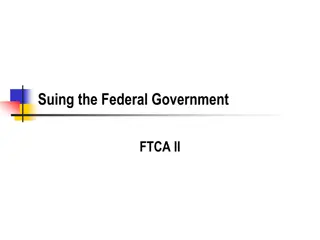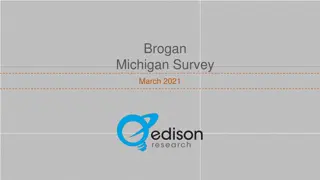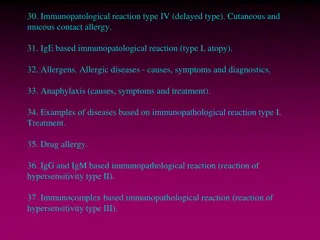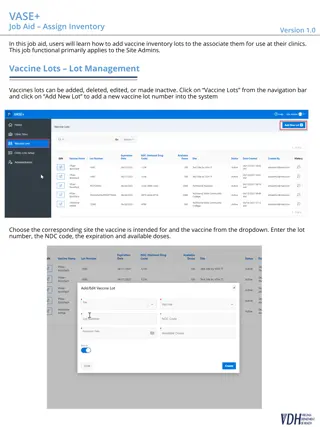Effect of Efgartigimod on Humoral Vaccine Responses in Patients with Autoimmune Diseases
The study explores the impact of Efgartigimod, a Neonatal Fc Receptor blocker, on humoral vaccine responses in patients with autoimmune diseases. It discusses how immunosuppressive therapies used in autoimmune disorders may affect susceptibility to infections and impair vaccine immunogenicity, highlighting the potential implications for patient care. The findings suggest a need for further research on the interplay between autoimmune treatments and vaccine responses.
Uploaded on Sep 19, 2024 | 1 Views
Download Presentation

Please find below an Image/Link to download the presentation.
The content on the website is provided AS IS for your information and personal use only. It may not be sold, licensed, or shared on other websites without obtaining consent from the author.If you encounter any issues during the download, it is possible that the publisher has removed the file from their server.
You are allowed to download the files provided on this website for personal or commercial use, subject to the condition that they are used lawfully. All files are the property of their respective owners.
The content on the website is provided AS IS for your information and personal use only. It may not be sold, licensed, or shared on other websites without obtaining consent from the author.
E N D
Presentation Transcript
Effect of Efgartigimod, a Neonatal Fc Receptor Blocker, on Humoral Vaccine Responses in Patients with Autoimmune Diseases Jeffrey T. Guptill,1 John W. Sleasman,2 Sophie Steeland,3 Magdalena Sips,3 Deborah Gelinas,3 Hans de Haard,3 Kevin Winthrop,4 Antoine Azar,5 James F. Howard Jr6 1Duke University School of Medicine, Department of Neurology, Durham, NC, USA; 2Duke University School of Medicine, Division of Allergy, Immunology, and Pulmonary Medicine, Durham, NC, USA; 3argenx, Ghent, Belgium; 4Oregon Health and Science University, Division of Infectious Disease, Portland, OR, USA; 5Johns Hopkins University School of Medicine, Division of Allergy and Clinical Immunology, Baltimore, MD, USA; 6The University of North Carolina at Chapel Hill, Department of Neurology, Chapel Hill, NC, USA 1
Disclosures Disclosures The ADAPT, ADAPT+, and phase 2 study in pemphigus were funded by argenx Jeffery T. Guptill has served as a consultant in past 12 months for Immunovant, Alexion, Apellis, Momenta, Ra Pharma, Grifols, Jacobus, Becton Dickinson, Cabaletta, Regeneron, argenx, Janssen, UCB, Toleranzia and Piedmont Pharmaceuticals. He receives industry grant support from UCB pharma for a fellowship training grant. Full disclosure statement available at: https://dcri.org/about-us/conflict-of- interest/. He is an MG trial site investigator for: Alexion, Janssen, UCB Pharma, argenx, Takeda; receives grant/research support from: NIH (NIAID, NINDS, NIMH), Centers for Disease Control and Prevention, and the Myasthenia Gravis Foundation of America Efgartigimod is an investigational agent that is not currently approved for use by any regulatory agency Medical writing and editorial support were provided by PRECISION Value & Health and funded by argenx 2
Immunosuppressive Therapies Used For Treatment of Autoimmune Disorders Immunosuppressive Therapies Used For Treatment of Autoimmune Disorders May Increase Susceptibility to Infections and Impair Immunogenicity of Vaccines May Increase Susceptibility to Infections and Impair Immunogenicity of Vaccines Treatment options (corticosteroids, NSISTs) employed in MG and other autoimmune disorders have the potential to1-3: Increase risk of infection Reduce therapeutic antibody response Impair cellular immune responses to vaccination It has been reported that glucocorticoids and BCDT substantially impair immunogenicity of mRNA vaccines to SARS-CoV-23,4 Do transient reductions in IgG levels caused by FcRn inhibition impair response to vaccination? BCDT, B-cell depleting therapy; FcRn, neonatal Fc receptor; MG, myasthenia gravis; mRNA, messenger ribonucleic acid; NSIST, nonsteroidal immunosuppressive therapy; SARS-CoV-2, severe acute respiratory syndrome coronavirus 2. 1. Sanders DB, et al. Neurology. 2016;87:419-425. 2. Patel SY, et al. Front Immunol. 2019;10(33):1-22. 2. Jolles S, et al. Clin Exp Immunol. 2016;188(3):333-341. 3. Deepak P, et al. medRxiv [Preprint]. 2021;2021.04.05.21254656. 4. Connolly CM, et al. Ann Rheum Dis. 2021;80(10):e164-e164. doi:10.1136/annrheumdis-2021-220972
Efgartigimod Blocks FcRn and Causes Transient Reductions in IgG Levels Efgartigimod Blocks FcRn and Causes Transient Reductions in IgG Levels FcRn recycles IgG, extending its half-life and serum concentration1 Efgartigimod, a human IgG1 Fc fragment, is a natural ligand of FcRn engineered for increased affinity to FcRn2,3 Efgartigimod was designed to outcompete endogenous IgG, preventing recycling, and promoting lysosomal degradation of IgG without impacting its production2-5 o Targeted reduction of all IgG subtypes o No reduction in IgM or IgA levels o No reduction in albumin levels o No increase in cholesterol gMG: maximum mean total IgG reduction of >60%; returned to baseline at week 124 Endothelial Cell Blood Vessel Endosome Endothelium Lysosome Image adapted from Kang TH, Jung ST. Exp Mol Med. 2019;51(11):1-9. Efgartigimod (Fc Fragment) FcRn IgG IgG Autoantibody Antibody Fc, crystallizable fragment; FcRn, neonatal Fc receptor; gMG, generalized myasthenia gravis; Ig, immunoglobulin. 1. Sesarman A, et al. Cell Mol Life Sci. 2010;67(15):2533-2550. 2. Ulrichts P, et al. J Clin Invest. 2018;128(10):4372-4386. 3. Vaccaro C, et al. Nat Biotech. 2005;23(10):1283-1288. 4. Howard JF Jr, et al. Lancet Neurol. 2021;20(7):526-536. 5. Nixon AE, et al. Front Immunol. 2015;6:176. 4
Evaluating Humoral Immunity and Response to Vaccination Evaluating Humoral Immunity and Response to Vaccination in Efgartigimod in Efgartigimod- -Treated Patients Treated Patients Response to T-cell dependent vaccines COVID-19 mRNA vaccines Influenza vaccines 13-valent conjugate pneumococcal vaccine ADAPT/ADAPT+ (gMG) Cyclic efgartigimod Effect of efgartigimod on humoral immune response to active immunization 1 cycle = 4 weekly infusions Up to 10 total cycles Response to T-cell independent vaccines 23-valent pneumococcal polysaccharide vaccine Pemphigus phase 2 Sustained dosing Fate of anti-microbial antibodies Anti-TT Anti-VZV Anti-PCP Effect of efgartigimod on existing humoral immunity Weekly or biweekly up to 34 weeks COVID-19, coronavirus disease 2019; gMG, generalized myasthenia gravis; IV, intravenous; mRNA, messenger ribonucleic acid; TT, tetanus toxoid; PCP, pneumococcal capsular polysaccharide; VZV, varicella zoster virus.
Impact of Efgartigimod on Protective Antibody Titers and Immunogenic Response Was Impact of Efgartigimod on Protective Antibody Titers and Immunogenic Response Was Evaluated in Patients with gMG in a Phase 3 Study and Extension Evaluated in Patients with gMG in a Phase 3 Study and Extension Vaccination procedures during the study Vaccinations (other than with live or live-attenuated viruses) were allowed per protocol if they occurred 48 hours before or 48 hours after efgartigimod administrations 167 gMG patients randomized 1:1 to receive 10 mg/kg IV efgartigimod or placebo DESIGN VACC. Open-Label Extension 26 weeks Cycle 1 Cycle 2 Evaluation of postvaccination IgG levels 11 patientsb(2 placebo; 9 efgartigimod) received influenza vaccines prior to or during the trial 1 patient received the 13-valent pneumococcus vaccine 1 patient received the 23-valent pneumococcus vaccine 7 patients (1 placebo, 6 efgartigimod) received COVID-19 vaccines during ADAPT+ (part B) Treatment cycles of 4 weekly IV infusions (1-hour infusion) Retreatment criteria 8 weeks since initiation of previous cycle Total MG-ADL 5 points (>50% nonocular) For MG-ADL responders, loss of MG-ADL response All patients receive initial treatment cycle Individualized treatment cycles ( 3 cycles in 26 weeks) DOSING Time between cycles determined by duration of CMIa CMI, clinically meaningful improvement; gMG, generalized myasthenia gravis; IV, intravenous; MG- ADL, Myasthenia Gravis Activities of Daily Living. a 2-point improvement for 4 consecutive weeks; b ADAPT, n=5; ADAPT+, n=6. Note: Patients requiring rescue therapy discontinued from the study treatment. 6
Impact of Efgartigimod on Protective Antibody Titers Was Evaluated Impact of Efgartigimod on Protective Antibody Titers Was Evaluated in Patients With Pemphigus in a Phase 2 Study in Patients With Pemphigus in a Phase 2 Study 15 patients with pemphigus enrolled in cohort 4 of an open-label non-controlled trial Vaccination procedures prior to study Patients with a history of vaccination within last 4 weeks prior to baseline or with planned vaccination during the study (except seasonal vaccination, e.g., influenza) were excluded DESIGN VACC. Follow-up Period Treatment-free 34 weeks 3 weeks Screening Evaluation of protective IgG levels Protective IgG antibody serum levels of anti- TT, anti-VZV, and anti-PCP were evaluated in all patients Only data from cohort 4 (n=15) are presented here Historical vaccination data were unknown Treatment Period DOSING 25 mg/kg IV efgartigimod weekly or every other week 7 IV, intravenous; TT, tetanus toxoid; PCP, pneumococcal capsular polysaccharide; VZV, varicella zoster virus.
Patients with gMG in the Placebo Arm of ADAPT Mounted Humoral Immune Patients with gMG in the Placebo Arm of ADAPT Mounted Humoral Immune Responses to Influenza Vaccines Responses to Influenza Vaccines Placebo Patient 1 Patient 2 Vaccination Vaccination 1000 1000 ULQ ULQ Colorado (B, Victoria) Phuket (B, Yamagata) Kansas (A, H3N2) Brisbane (A, H1N1) 100 100 Titer in HAI Titer in HAI Protective Protective 10 10 1 1 0 10 20 30 40 0 20 40 60 80 100 Study day Study day MMF 500 mg BID, Cyclosporine 50 mg BID, Prednisone 20 mg QD Immunosuppressants: None In the placebo arm, both patients mounted an immune response after vaccination, with levels above the protective titers for most strains BID, twice a day; gMG, generalized myasthenia gravis; HAI, hemagglutination inhibition; Ig, immunoglobulin; MMF, mycophenolate mofetil; QD, once a day; ULQ, upper limit of quantification.
Transient IgG Reduction With Efgartigimod Treatment Did Not Compromise Transient IgG Reduction With Efgartigimod Treatment Did Not Compromise Humoral Immune Response to Influenza Vaccination in Patients With gMG Humoral Immune Response to Influenza Vaccination in Patients With gMG Efgartigimod Efgartigimod Representative patients vaccinated between treatment cycles Representative patients vaccinated during treatment cycles Patient 7 Patient 11 Vaccination Vaccination 15000 10000 1000 1000 ULQ ULQ 8000 Total IgG, g/mL Total IgG, g/mL Titer in HAI Titer in HAI 10000 6000 100 100 Protective Protective 4000 5000 10 10 2000 Efgartigimod cycle 0 0 1 1 Total IgG Colorado (B, Victoria) Phuket (B, Yamagata) Kansas (A, H3N2) Brisbane (A, H1N1) Study day 200 300 400 500 0 AZA 50 mg BID, Methylprednisone 8 mg QD 50 100 150 200 Study day Immunosuppressants: AZA 250 mg QD Patient 9 Patient 10 Vaccination Vaccination 8000 10000 1000 1000 ULQ ULQ 8000 Total IgG, g/mL Total IgG, g/mL 6000 Titer in HAI Titer in HAI 6000 100 100 4000 Protective Protective 4000 10 10 2000 2000 0 0 1 1 Study day AZA 50 mg TID, Methylprednisone 18 mg QOD Study day 150 200 250 300 350 400 0 50 100 150 200 250 Immunosuppressants: MMF 1500 mg BID AZA, azathioprine; gMG, generalized myasthenia gravis; HAI, hemagglutination inhibition; Ig, immunoglobulin; QD, once a day; QOD, every other day; TID, three times a day; ULQ, upper limit of quantification.
Humoral Immune Response to Influenza Vaccination in Patients With gMG Humoral Immune Response to Influenza Vaccination in Patients With gMG Summary All but one patient treated with efgartigimod mounted humoral responses to influenza vaccines, with titers above protective thresholds in most cases Influenza was not reported in 10/11 vaccinated patients Collectively, these results suggest that FcRn blockade at the time of vaccination did not interfere with humoral immune response to influenza vaccines Fc, crystallizable fragment; FcRn, neonatal Fc receptor; gMG, generalized myasthenia gravis.
Patients Receiving Efgartigimod Mounted Humoral Immune Responses to Both Patients Receiving Efgartigimod Mounted Humoral Immune Responses to Both T Cell T Cell- -Independent and Independent and Dependent Pneumococcal Vaccines Dependent Pneumococcal Vaccines Response to 23-valent pneumococcalvaccine (T cell-independent) Response to 13-valent pneumococcalvaccine (T cell-dependent) Patient 12 Patient 6 Vaccination 2 Efgartigimod cycle Vaccination 1 Efgartigimod cycle Total IgG Vaccination 10000 100000 10000 6000 Total IgG Pneumococcus lgG titer, ng/mL Pneumococcus lgG titer, ng/mL PCV13-S1 PCV13-S4 10000 1000 8000 PCV-S3 PCV-S3 Protective 1000 Protective Total IgG, g/mL Total IgG, g/mL PCV13-S4 4000 PCV13-S5 100 6000 PCV13-S5 100 PCV13-S9V 10 PCV13-S6A PCV13-S7 10 4000 PCV13-S6b PCV13-S6b 1 2000 PCV13-S7 1 PCV-S18c 2000 PCV13-S9V PCV13-S14 0.1 0.1 PCV13-S14 PCV-13-S1 0.01 0.01 0 0 PCV-S18C PCV13-S19A Study day Study day 0 200 0 200 200 250 350 100 PCV13-S19A PCV-S19F PCV-S19F PCV-S23F PCV-S23F Immunosuppressants: Prednisone 5 mg QOD, Prednisolone 7.5 mg QOD MMF 500 mg BID, Methylprednisone 4 mg QD Clear humoral immune response towards all evaluated strains after vaccination After initiation of subsequent efgartigimod treatment cycles, titers were lowered for some strains, but typically remained above pre-vaccination levels BID, twice a day; Ig, immunoglobulin; PCV, pneumococcus conjugate vaccine; QD, once a day; QOD, every other day.
Most Patients Receiving Efgartigimod Were Able to Mount Humoral Immune Most Patients Receiving Efgartigimod Were Able to Mount Humoral Immune Responses to COVID Responses to COVID- -19 Vaccines 19 Vaccines Placebo Efgartigimod Efgartigimod Efgartigimod Vaccinated between treatment cycles Vaccinated during a treatment cycle No treatment with efgartigimod or concomitant immunosuppressives Vaccinated during IgG nadir Patient 15 (Pfizer) Patient 16 (Pfizer) Patient 17 (Pfizer) Patient 18 (Pfizer) COVID-19 S-RBD IgG (AU/mL) COVID-19 S-RBD IgG (AU/mL) COVID-19 S-RBD IgG (AU/mL) COVID-19 S-RBD IgG (AU/mL) Vaccination 2 Vaccination 2 Vaccination 1 1000 Vaccination 1 Vaccination 1 Vaccination 2 Vaccination 1 Vaccination 2 1000 10000 1000 1000 100 100 100 100 10 LLOQ 10 10 LLOQ LLOQ 10 1 LLOQ 1 1 1 -150 0.1 -60 -40 -20 0 20 40 -50 -25 0 25 50 75 100 -100 -50 0 50 100 -100 -80 -60-40 -20 25 20 40 60 80 100 Days after 2nd vaccination Days after 2nd vaccination Days after 2nd vaccination Days after 2nd vaccination None None None MMF 1500 mg BID (Patient BMI: 47 kg/m2) Immunosuppressants: S-RBD IgG None of the vaccinated patients experienced a known COVID-19 infection prior to the vaccine or prior to the last post-vaccination sample. Lowest total IgG Efgartigimod cycle BID, twice a day; BMI, body mass index; COVID-19, coronavirus disease 2019; Ig, immunoglobulin; LLOQ, lower limit of quantification; S-RBD, spike protein-receptor binding domain.
IgG Reduction With Prolonged Efgartigimod Treatment Did Not Compromise IgG Reduction With Prolonged Efgartigimod Treatment Did Not Compromise Existing Humoral Immunity in Patients With Pemphigus Existing Humoral Immunity in Patients With Pemphigus Protective antibody titers were measured in 15 patients treated with weekly or biweekly efgartigimod up to 34 weeks Change from baseline for protective antibody titers and total IgG Mean (SEM) serum levels of protective antibodies over time Tetanus toxoid (TT) Varicella zoster virus (VZV) Pneumococcal capsular polysaccharide (PCP) 250 1.5 3000 100 Change from baseline, % 200 80 Anti-PCP IgG, mg/L Anti-TT IgG, IU/mL Anti-VZV IgG, IU/L 1.0 2000 150 60 100 40 0.5 1000 50 20 0 0 0 0 0 50 100 150 Study days 200 250 300 350 0 50 100 150 Study days 200 250 300 350 0 50 100 150 Study days 200 250 300 350 0 50 100 150 Study days 200 250 300 350 Dotted line indicates a minimally protective titer for anti-TT responses, 0.1 IU/mL (estimation of the long-term immunity), and for anti-VZV responses, 150 IU/L. Efgartigimod treatment period Anti-VZV Anti-TT Anti-PCP lgG Protective antibody titers for anti-TT, -VZV, and PCP return to normal upon treatment termination, suggesting no negative effect on long-lived memory plasma cell responses Ig, immunoglobulin; SEM, standard error of the mean. Goebeler M, et al. Br J Dermatol. 2021 Oct 5. doi: 10.1111/bjd.20782.
Safety Safety Pemphigus Study2 ADAPT Study1 Overall Infection AEsa Infections by Type Infections by Type 0.0% 11.9% Nasopharyngitis Nasopharyngitis 18.1% 10.7% 27.0% 5.0% Respiratory tract infection Urinary tract infection 4.8% 13.0% 46.4% 9.5% Urinary tract infection 0.0% 4.8% 37.3% Rhinitis 13.0% 2.4% Sinusitis 0.0% 11.0% Bronchitis 0.0% 3.6% Influenza 3.6% 2.4% 5.0% Gasteroenteritis 7.0% Ear infection n=31/83 n=39/84 0.0% 0.0% 5.0% Respiratory tract infection Cystitis 7.0% 2.4% Cycle 1 n (%) 28/84 (33.3) 21/83 (25.3) 5.0% 6.0% Impetigo Bronchitis 7.0% 2.4% Cycle 2 n (%) 17/63 (27.0) 11/57 (19.3) 0 10 20 30 0 10 20 30 Patients, % Patients, % Efgartigimod (n=84) Placebo (n=83) Efgartigimod 10 mg (n=19) Efgartigimod 25 mg (n=15) Infections occurred with similar frequency in the efgartigimod and placebo arm, and most were mild or moderate All events were of mild or moderate intensity a3 severe infections: influenza, pharyngitis (efgartigimod); upper respiratory tract infection (placebo). AE, adverse event. 1. Howard JF Jr, et al. Lancet Neurol. 2021;20(7):526-536. 2. Goebeler M, et al. Br J Dermatol. 2021 Oct 5. doi: 10.1111/bjd.20782. 14
Summary Summary Efgartigimod treatment was well tolerated in patients with gMG and pemphigus, and most infections were of mild or moderate intensity Total IgG levels are transiently reduced after efgartigimod treatment, but humoral immune responses to influenza or pneumococcal vaccine immunity appear to remain intact in patients with gMG In patients with pemphigus, IgG reduction with sustained efgartigimod therapy did not appear to impact existing humoral immunity as anti-PCP, TT, and VZV IgG levels did not drop below minimally protective thresholds Ig, immunoglobulin; gMG, generalized myasthenia gravis; PCP, pneumococcal capsular polysaccharide; SEM, standard error of the mean; TT, tetanus toxoid; VZV, varicella zoster virus.
Total IgG Levels Were Reduced After Total IgG Levels Were Reduced After Efgartigimod Patients With Patients With gMG gMG, With Clear Immune Responses in Most Patients (cont d) , With Clear Immune Responses in Most Patients (cont d) Vaccination in treatment-free period Efgartigimod Treatment in All Flu Treatment in All Flu- -Vaccinated Vaccinated Vaccination in middle of treatment cycle with maximally reduced IgG levels patient 11-efgartigimod patient 7-efgartigimod patient 3-efgartigimod patient 6-efgartigimod 15000 10000 10000 6000 1000 1000 1000 1000 ULQ ULQ ULQ ULQ 8000 8000 Total IgG, g/mL Total IgG, g/mL Total IgG, g/mL Total IgG, g/mL 10000 Titer in HAI Titer in HAI Titer in HAI 4000 Titer in HAI 100 6000 6000 100 100 100 Protective Protective Protective Protective 4000 4000 5000 2000 10 10 10 10 2000 2000 0 0 1 0 1 1 0 1 Vaccination 0 50 100 150 200 200 300 400 500 Vaccination 0 50 100 150 200 0 100 150 200 250 Vaccination Vaccination Study day Study day Study day Study day patient 9-efgartigimod patient 4-efgartigimod patient 5-efgartigimod patient 8-efgartigimod 8000 10000 10000 10000 1000 1000 1000 1000 ULQ ULQ ULQ ULQ 8000 8000 8000 Total IgG, g/mL 6000 Total IgG, g/mL Total IgG, g/mL Total IgG, g/mL Titer in HAI Titer in HAI Titer in HAI Titer in HAI 6000 100 100 100 100 6000 6000 Protective 4000 Protective Protective Protective 4000 4000 4000 10 10 10 10 2000 2000 2000 2000 1 0 1 0 0 1 0 1 0 50 100 150 200 Vaccination 0 50 100 150 200 Vaccination 0 50 100 150 Vaccination 0 50 100 150 200 250 Vaccination Influenza Study day Study day Study day Study day patient 10-efgartigimod 10000 Total IgG levels decreased after efgartigimod treatment as expected Total IgG antibody 1000 ULQ 8000 Total IgG, g/mL Colorado (B, Victoria) Influenza was reported in 1 vaccinated patient (patient 5, day 127) Titer in HAI 6000 100 Phuket (B, Yamagata) Protective 4000 10 Kansas (A, H3N2) 2000 Clear immune responses were seen to most influenza strains, except in 1 patient (patient 6) Brisbane (A, H1N1) 0 1 Vaccination 150 200 250 300 350 400 Efgartigimod cycle Study day gMG, generalized myasthenia gravis; HAI, hemagglutination inhibition; Ig, immunoglobulin.
Most Patients Receiving Efgartigimod Were Able to Mount Humoral Immune Most Patients Receiving Efgartigimod Were Able to Mount Humoral Immune Responses to COVID Responses to COVID- -19 Vaccines 19 Vaccines Patient 18-pfizer Patient 16-pfizer Patient 13-pfizer Patient 15-pfizer 1000 1000 1000 1000 COVID-19 S-RBD IgG (AU/mL) COVID-19 S-RBD IgG (AU/mL) COVID-19 S-RBD IgG (AU/mL) COVID-19 S-RBD IgG (AU/mL) 100 100 100 100 10 LLOQ 10 10 10 LLOQ LLOQ LLOQ 1 1 1 1 0.1 -60 -40 -20 0 20 40 -50 -25 0 25 50 75 100 -80 -60 -20 0 20 -100 -80 -60 -40 -20 25 20 40 60 80 100 Vaccination 1 Vaccination 2 Vaccination 1 Vaccination 2 Vaccination 1 Vaccination 2 Vaccination 1 Vaccination 2 Days after 2nd vaccination Days after 2nd vaccination Days after 2nd vaccination Days after 2nd vaccination Patient 12-pfizer Patient 17-pfizer Patient 14-moderna 1000 10000 1000 COVID-19 S-RBD IgG (AU/mL) COVID-19 S-RBD IgG (AU/mL) COVID-19 S-RBD IgG (AU/mL) 1000 100 100 100 10 10 LLOQ LLOQ 10 LLOQ S-RBD IgG 1 1 1 -60 -40 -20 0 20 40 60 -150 -100 -50 0 50 100 -100 -50 0 50 Lowest total IgG Vaccination 1 Vaccination 2 Vaccination 1 Vaccination 2 Vaccination 1 Vaccination 2 Receiving efgartigimod Days after 2nd vaccination Days after 2nd vaccination Days after 2nd vaccination
